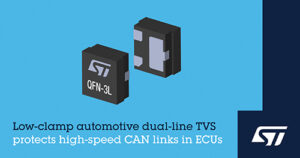STMicroelectronics’ ESDCAN03-2BM3Y dual, automotive-qualified low-capacitance transient voltage suppressor (TVS) protects CAN and CAN-FD interfaces by delivering all-round performance in a tiny package.
 At 1.1mm x 1.0mm, the new TVS meets the automotive industry’s need for highly miniaturized and high-performing protection devices for the increasing numbers of high-density electronic control units (ECU) such as advanced driver-assistance systems (ADAS), autonomous-driving controllers, and automotive gateways.
At 1.1mm x 1.0mm, the new TVS meets the automotive industry’s need for highly miniaturized and high-performing protection devices for the increasing numbers of high-density electronic control units (ECU) such as advanced driver-assistance systems (ADAS), autonomous-driving controllers, and automotive gateways.
By using this device, it’s estimated that designers can save 75 percent or more of the PCB space needed by conventional TVS in SOT23-3L and SOT323-3L packages.
The ESDCAN03-2BM3Y ensures outstanding transient protection with clamping voltage as low as 33V (8/20µs at 1A) and 37V (transmission-line pulse (TLP) at 16A). Passing ISO 16750-2 jump-start and reversed-battery tests, the device is also extremely reliable, withstanding 15kV ESD contact discharge (ISO 10605) and, with 3.3A peak pulse rating, able to handle strong current surges.
On top of CAN and CAN-FD, the line capacitance of just 3.3pF allows the TVS to protect high-speed and high-data-rate buses such as FlexRay™ and USB. In addition, such minimal capacitance eases PCB design by allowing extra margin when laying out signal paths.
The maximum junction temperature rating of 175° C allows deployment in locations throughout the vehicle, from the cabin to the engine compartment with severe mission profiles. With extremely low leakage current of 50nA at 24V, the ESDCAN03-2BM3Y minimizes battery drain when the vehicle is turned off, helping to preserve the state of charge and maximize the driving range in electric-vehicle (EV) applications.
The ESDCAN03-2BM3Y TVS is in production now in the leadless DFN1110 package, which has wettable flanks that facilitate high-speed automatic optical inspection after soldering for high quality-assurance targets.
Filed Under: Circuit Protection, Components, News, Products


Questions related to this article?
👉Ask and discuss on EDAboard.com and Electro-Tech-Online.com forums.
Tell Us What You Think!!
You must be logged in to post a comment.